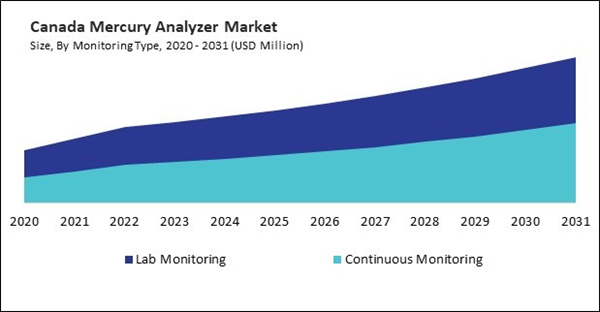The US market dominated the North America Mercury Analyzer Market by Country in 2023, and would continue to be a dominant market till 2031; thereby, achieving a market value of$90.78 millions by 2031. The Canada market is registering a CAGR of 8.2% during (2024 - 2031). Additionally, The Mexico market would showcase a CAGR of 7.2% during (2024 - 2031).
Regulatory requirements, public health concerns, technological advancements, and industry-specific needs have driven the adoption of mercury analyzers. Growing awareness of the adverse health effects of mercury exposure, especially on neurological development, has prompted governments, healthcare organizations, and communities to prioritize mercury monitoring and mitigation efforts. Mercury analyzers play a crucial role in assessing human exposure levels and identifying sources of contamination. Furthermore, advances in analytical instrumentation have led to the development of mercury analyzers with enhanced sensitivity, accuracy, and detection limits. These technological improvements enable more precise measurement of low-level mercury concentrations, even in complex sample matrices.
Moreover, scientists and researchers use mercury analyzers in environmental studies to investigate mercury cycling, bioaccumulation, and ecological impacts. These studies provide valuable insights into the sources, fate, and transport of mercury in the environment, guiding policy decisions and pollution prevention efforts. Ongoing research focuses on improving analytical methods for mercury analysis, including sample preparation techniques, instrumental methods, and quality assurance protocols. Advances in analytical chemistry contribute to the continued refinement of mercury analyzers and their applications in diverse fields.
As Canada’s food and beverage industry grows, a heightened focus will likely be on quality control and safety standards. This could lead to an increased demand for mercury analyzers as part of the testing and monitoring processes to ensure that products meet regulatory requirements. According to the Government of Canada, in 2022, the food and beverage processing sector emerged as Canada’s leading manufacturing industry based on production value, boasting sales of manufactured goods totaling $156.5 billion. This could lead to an increased demand for mercury analyzers as part of the testing and monitoring processes to ensure that products meet regulatory requirements. Hence, North America’s growing food and beverage processing sector is expected to boost the demand for mercury analyzers in the region.
Based on Type, the market is segmented into Cold Vapor Atomic Absorption (CVAA) and Cold Vapor Atomic Fluorescence (CVAF). Based on End-Use Industry, the market is segmented into Environment Monitoring, Food Industry, Oil & Gas and Petrochemical, Healthcare and Others. Based on Monitoring Type, the market is segmented into Lab Monitoring and Continuous Monitoring. Based on countries, the market is segmented into U.S., Mexico, Canada, and Rest of North America.
List of Key Companies Profiled
- Thermo Fisher Scientific, Inc.
- PerkinElmer, Inc.
- Milestone S.r.L.
- Analytik Jena GmbH (Endress+Hauser AG)
- Hitachi High-Technologies Corporation (Hitachi Ltd.)
- Ametek, Inc.
- Lumex Instruments
- Tekran Instruments Corporation
- ENVEA
- Ohio Lumex Co., Inc.
Market Report Segmentation
By Type
- Cold Vapor Atomic Absorption (CVAA)
- Cold Vapor Atomic Fluorescence (CVAF)
By End-Use Industry
- Environment Monitoring
- Food Industry
- Oil & Gas and Petrochemical
- Healthcare
- Others
By Monitoring Type
- Lab Monitoring
- Continuous Monitoring
By Country
- US
- Canada
- Mexico
- Rest of North America
Table of Contents
Companies Mentioned
- Thermo Fisher Scientific, Inc.
- PerkinElmer, Inc.
- Milestone S.r.L.
- Analytik Jena GmbH (Endress+Hauser AG)
- Hitachi High-Technologies Corporation (Hitachi Ltd.)
- Ametek, Inc.
- Lumex Instruments
- Tekran Instruments Corporation
- ENVEA
- Ohio Lumex Co., Inc.
Methodology

LOADING...









